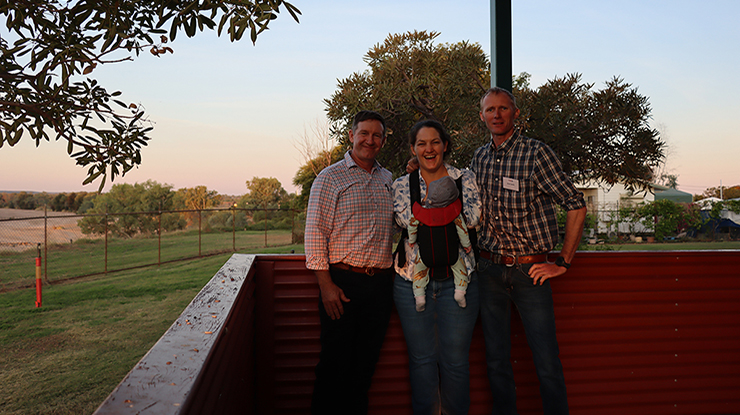Reaping the rewards of rest
25 July 2023
 (L–R) Michael Lyons (facilitator), Anita McNamara and Eiren Smith were part of the ‘resting country’ panel discussion at the Hughenden BeefUp forum in June 2023.
(L–R) Michael Lyons (facilitator), Anita McNamara and Eiren Smith were part of the ‘resting country’ panel discussion at the Hughenden BeefUp forum in June 2023.
Key points:
- Rest helps to accelerate improvements in land condition, particularly in good seasons. It allows for the recruitment and establishment of new grass plants and an increase in the size of existing plants.
- If introducing rest to your management strategy, take a gradual approach, plan ahead and make sure everyone in the business is on the same page.
- It’s not a set and forget – continue to monitor your paddocks (both the poorer and more productive ones).
For beef and sheep producer Anita McNamara, implementing a rest period for paddocks has helped to restore land condition and productivity on her family’s property south of Hughenden, in north Queensland.
Anita shared her experiences as part of a ‘resting country’ panel discussion at the Hughenden BeefUp forum in June, alongside producers Eiren Smith and Michael Lyons and presenters, Brett Abbott (CSIRO) and Bob Shepherd (DAF).
For Anita, declining land condition, patches of severe overgrazing and ongoing grasshopper plagues were the motivation to consider a new management approach, including resting country.
“We were trying to lighten off in dry years, we’d get smashed with grasshoppers, so we knew something had to change, the ecology was not functioning well at all,” Anita said.
Anita and her family took a step-by-step approach, experimenting with small areas before making resting part of their ongoing management strategy. They now aim to rest every paddock for 60 days over the wet season. While they may not always hit the 60-day target, even a 30-day rest is better than none at all.
Anita has seen results over time and has learnt how to make seasonal adjustments to get the most from their resting strategy.
Whilst it was difficult to see the benefits of resting during the dry years of 2016–2020, the good wet seasons of 2020–21 and 2021–22 saw mass Mitchell grass germination and then establishment over large areas. This resulted in an improvement in land condition from a C/D rating towards an A/B rating, and subsequently an improvement in the carrying capacity of the country.
Following the 2019 Monsoon flood event, the property saw mass Mitchell grass germination, however too much grazing pressure and lack of follow-up rain meant they did not get mass establishment. This highlighted the importance of matching stocking rate to seasonal carrying capacity to really see the benefits of resting country.
“I used to grade the fence line and would be trying to avoid tussocks because they were few and far between,” Anita said.
“Now we know we’ve got enough grass ahead of us to get through to our green date and our production pate.”
Also using rest as part of his management strategy, beef producer Eiren Smith has followed in his father’s footsteps to maximise feed production and resilience of the feed base on their Charters Towers property.
Eiren’s family first started resting country following drought and saw the benefits in its recovery in the following years. They now aim to rest 50% of their country all year round.
“We will increase the percentage of country resting during the wet season. If it’s very dry and water infrastructure is struggling, we will spread cattle out through the dry season,” Eiren said.
Implementing a rest period for paddocks has also benefited their bottom line.
“If we can produce more feed, we can run more cows and make more money. It’s cheaper than buying the block next door.”
Starting out
For producers wanting to introduce rest into their management strategy, the panel recommended a well-planned and gradual approach.
“Work out a grazing system that matches what you want to do with your business,” Anita said.
“Start with small experiments and a grazing plan so everyone in the business is on the same page.
“Focus on what you can do, rather than what you can’t.”
Producers who want to rest country may need to consider an investment in some infrastructure.
“Of course, there will be some hurdles,” Eiren said.
“At first, we found it was hard to keep cattle out and needed more fencing.
"Do the sums and make sure you’ve also got the water infrastructure to handle it.”
DAF Principal Extension Officer and deliverer of the Grazing Land Management EDGE course, Bob Shepherd said make sure the improvement of degraded country doesn’t come at the expense of the better country.
“It’s important to look across all your paddocks; look at the condition and balance of your paddocks and stocking rates,” Bob said.
“Note the paddocks in fair condition and make sure you monitor and maintain those – be careful not to wet season spell poor condition paddocks only to overgraze the ones in better condition.
“Destock the paddocks that require a wet season spell at the final round muster of the year. Then the paddock will be empty for the following wet season.
“Don’t wait for the rain to start before deciding to spell the paddock; the decision has to be made in the previous year.”
Keeping the lines of communication open
Part of making any new strategy work is to ensure that everyone in the business is on the same page.
“When we first started (resting), I was convinced but I couldn’t work out why everyone else wasn’t,” Anita said.
“If you want to make a change, then take responsibility but make sure you’re communicating with others.”
Anita and Eiren have both worked alongside their families to determine what works for their business as well as benefiting from industry programs and the insights of other producers.
“I appreciate the support and ideas that other producers have given me,” Anita said.


